Viola tenuisecta Zumwalde & H.E.Ballard, ined.
Common names:
Virginia Shale Woodland Violet
Synonyms:
None.
Description:
Acaulescent rosulate perennials from thick rhizome, ≤ 15 cm tall; foliage and peduncles blue-green, upper surface of leaf blades darker than lower, petioles, lower surface of blades, peduncles, calyx and often blade margins purple-tinged, glabrous throughout; stipules free, irregularly glandular-fimbriate; homophyllous, leaves spreading, smallest leaf blades palmatifid or biternately divided, largest during chasmogamous flower biternately to subtriternately divided, during fruit becoming tri- to tetraternately dissected into 17–27 narrowly linear narrowly rounded ultimate lobes, primary divisions in fruit often constricted at base into a very slender elongate "petiolule", largest ≤ 110 × 150 mm, outline ovate in flower, orbicular to reniform in fruit, base subcordate to cordate, margins entire or with a minute subapical tooth on either margin, eciliate, apex broadly rounded; chasmogamous peduncle held above the leaves in early flower, often among or below leaves later; chasmogamous flower ≤ 21 mm; calyx glabrous, eciliate; lowest sepals ovate-lanceolate to narrowly ovate, broadly acute to obtuse; auricles short and entire, becoming quadrate and weakly elongating to 1.5 mm in fruit; corolla blue to purple, exposed proximal portion of bottom petal white, throat white; spur short-globose; lateral petals bearded with filiform to narrowly linear hairs, spurred petal glabrous; chasmogamous capsule green; cleistogamous flowers produced after chasmogamous, the peduncle declined, arching just before dehiscence, very short (often scarcely more than 2 × as long as the capsule); cleistogamous capsule 6–9 mm, green drying tan or purple-tinged with fine purple spots (very rarely unspotted), glabrous; seeds 1.7–2.4 × 1.1–1.5 mm, gray, gray-brown, or light to medium (reddish-)brown, unspotted or with sparse to dense minute raised black spots.
Similar species:
This species is distinctive in its bicolorous extremely dissected summer leaf blades, which are tri- to tetraternately divided into slender ultimate segments, with the primary divisions often constricted into a slender elongate "petiolule". It is most similar to other homophyllous cut-leaved taxa in the Pedatifida and Subsinuata species groups. Besides its strictly glabrous foliage and more extensively dissected leaf blades, this species differs from V. brittoniana and V. pedatifida in its broader acute to obtuse eciliate sepals, short entire auricles, glabrous spurred petal, finely spotted cleistogamous capsule on a very short declined peduncle, and gray to brown unspotted or minutely spotted seeds; and can be distinguished from V. baxteri and V. subsinuata by its eciliate sepals, finely spotted cleistogamous capsule on a very short declined peduncle, and gray to brown unspotted or minutely spotted seeds.
Ecology:
Dry to seasonally moist less acidic sandy soils and rock outcrops in shaded microsites in and around shale barrens openings.
Distribution:
County-level endemic of Alleghany and Bath Cos., VA.
Rarity:
State listed in VA [as Viola species 1].
Phenology:
Chasmogamous flower March–April, chasmogamous fruit April–May, cleistogamous fruit May–August.
Affinities:
This species belongs to the Acaulescent Blue Violet lineage, sect. Nosphinium W.Becker, subsect. Boreali-Americanae (W.Becker) Gil-ad, in the Subsinuata species group.
Hybrids:
None.
Comments:
This is a recently detected new species in Virginia's shale barrens region long known as disjunct populations of V. pedatifida. It is one of the rarest violets in North America. Essentially non-existent in national and regional herbaria prior to recent investigation, it is a prime example of the need for intensive fieldwork and integrative taxonomic studies, and of the value of knowledgeable local botanists. It was initially interpreted as a waif occurrence of Viola pedatifida by Platt (1950). Subsequent Virginia botanists including Tom Wieboldt and Johnny Townsend relocated historical sites and determined that Platt's populations represented ostensibly native occurrences, and interpreted them as disjunct populations of Viola pedatifida. The taxon was completely ignored by violet specialists and by lay taxonomists outside that region. Wieboldt and Townsend introduced me to the populations in 2012, and shortly afterward graduate student Bethany Zumwalde initiated integrative taxonomic studies on this taxon and others in the V. pedatifida and V. subsinuata species groups. She eventually demonstrated that the present taxon is a highly distinctive evolutionary species with a unique ecological niche in less acidic shale woodlands and treed inclusions adjacent to shale barrens openings (Zumwalde 2015). It is restricted to three small parallel mountain ranges straddling Allegheny and Bath Counties of western montane Virginia, joining other narrow Virginia endemics associated with shale barrens, including Clematis addisonii Britton (4 counties, G1? S1? status) and C. viticaulis Steele (2 counties, G1 S1S2, federally threatened). Macromorphological features, micromorphological traits of lateral petal trichomes and seed coats, and microsatellite diversity demonstrate that this species belongs to the Subsinuata species group and has no close relationship with V. pedatifida. Initial studies of this taxon inspired the extensive integrative taxonomic studies employed by our research group with other violets in our region, leading to detection of much greater evolutionary diversity in our violet flora than previously appreciated.
Literature Cited:
Platt, R. B. 1950. Two mid-Appalachian violets. Castanea 15: 126-129.
Zumwalde, B. A. 2015. A systematic revision of the Viola pedatifida group and evidence for the recognition of Viola virginiana, a new narrow endemic of the Virginia shale barrens. M.S. thesis. Ohio University, Athens, OH.
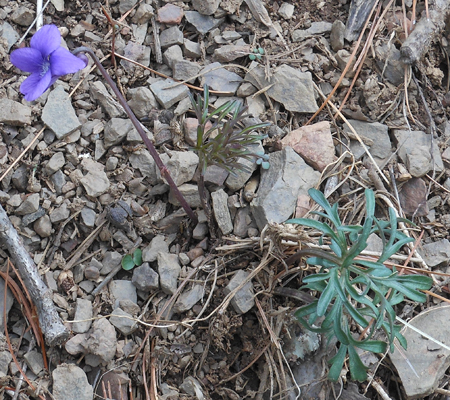
Chasmogamous flowering habit by Harvey Ballard
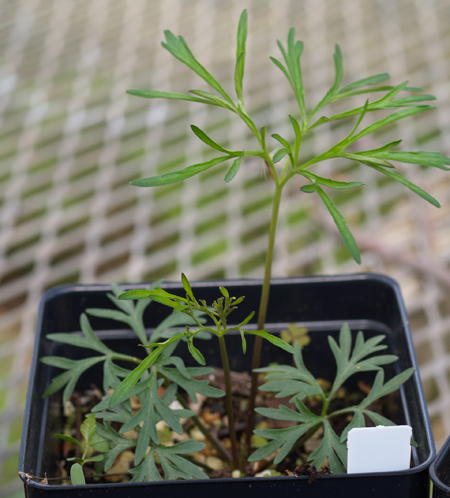
Chasmogamous flowering habit (garden plant) by Bethany Zumwalde
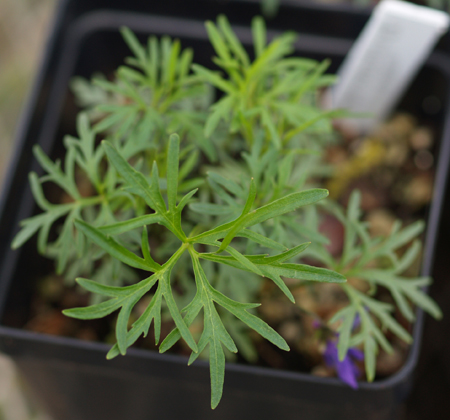
Leaves during chasmogamous flower (garden plant) by Bethany Zumwalde

Chasmogamous flower front view (garden plant) by Bethany Zumwalde
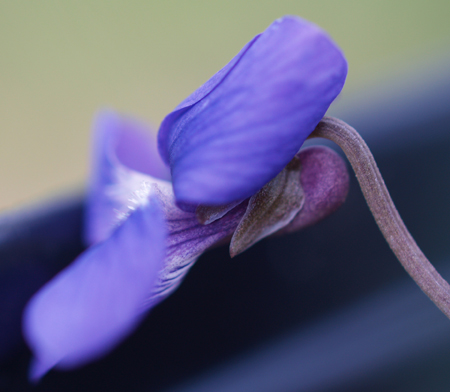
Chasmogamous flower profile view (garden plant) by Bethany Zumwalde
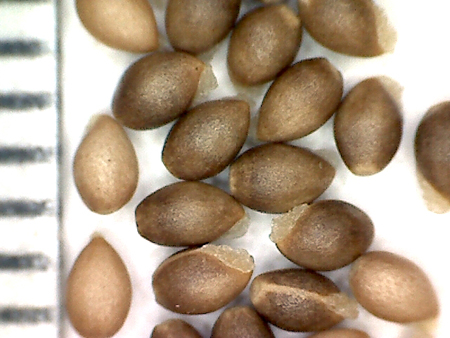
Seeds from herbarium specimen: Transplanted from VA, Bath Co., Beards Mountain, just off trail along central ridge, 2017, J. Hastings JH17003A (BHO)
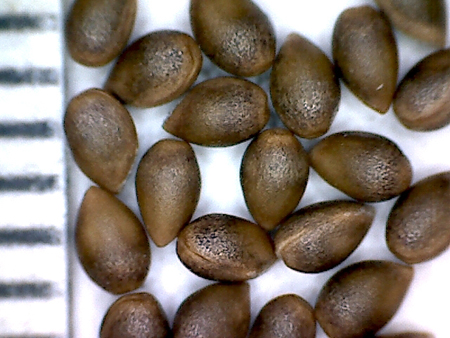
Seeds from herbarium specimen: Transplanted from VA, Bath Co., Beards Mountain, immediately below central ridge on E side of mountain, more or less directly above Wallawhatoola Road foot bridge, 2017, J. Hastings JH17004D (BHO)
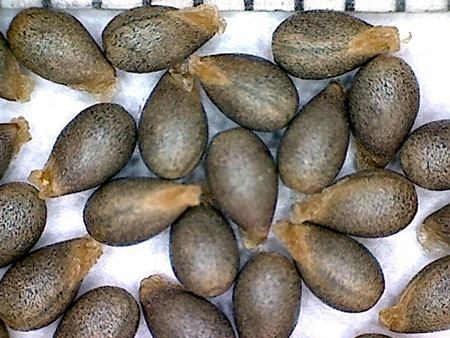
Seeds from herbarium specimen: Transplanted from VA, Bath Co., Beards Mountain, plant Z, 2014, B. Zumwalde s.n. (BHO)
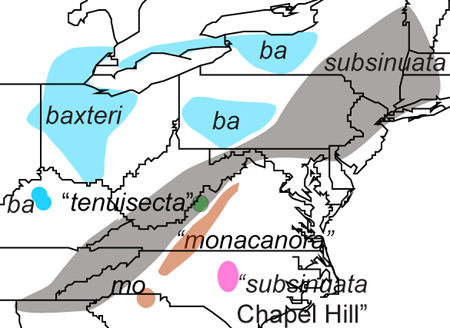
Map of taxa in the Subsinuata species group by Harvey Ballard